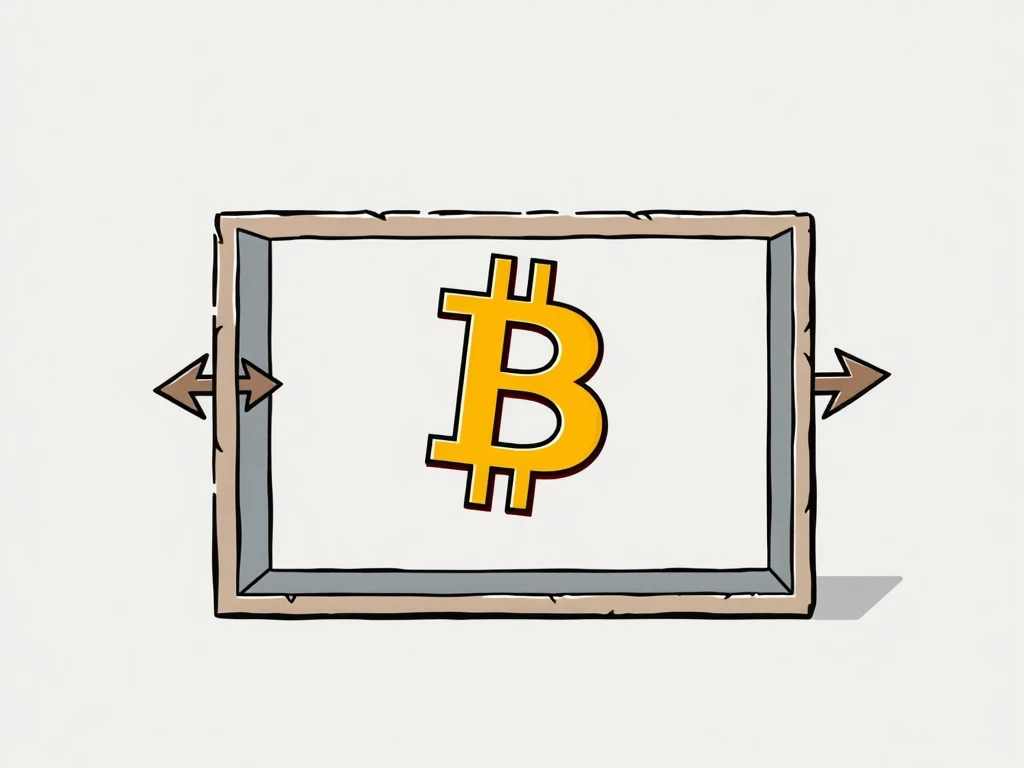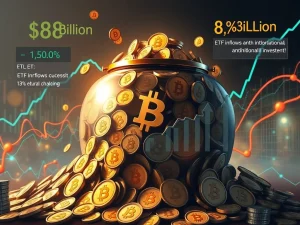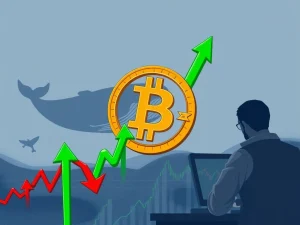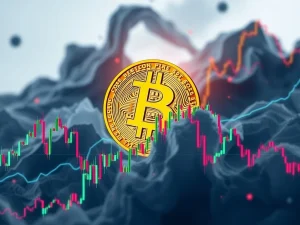Decoding Bitcoin’s Stuck Price: Is a Breakout Imminent?

Is the sideways shuffle in Bitcoin price making you scratch your head? You’re not alone. For weeks, Bitcoin (BTC) has been trading within a frustratingly narrow range, leaving investors and traders wondering: Why is Bitcoin price stuck? Let’s dive into the key factors holding Bitcoin captive and explore what might trigger the next big move.
Decoding Bitcoin’s Price Stagnation: Unpacking the Key Factors
Bitcoin’s recent price action can be best described as range-bound, oscillating between $82,400 and $85,300 since mid-March. Breakout attempts in either direction have been quickly thwarted, leading to this period of market indecision. Several interconnected elements are contributing to this Bitcoin price stuck scenario:
- Unpredictable US Economic Policies: The ever-shifting landscape of US economic policy is injecting uncertainty into the markets, impacting risk assets like Bitcoin.
- Liquidity Contraction: A decrease in the flow of fresh capital into the crypto market is dampening speculative activity and limiting significant price swings.
- Technical Setups: Current technical patterns on Bitcoin charts are creating a tug-of-war between buyers and sellers, contributing to the price consolidation.
- Trade War Fears vs. Pro-Bitcoin News: Conflicting signals from global trade tensions and positive crypto developments are creating a tug-of-war, leaving the market in a state of equilibrium.
Bullish vs. Bearish Signals: A Market Tug-of-War
The current market analysis reveals a battleground of bullish and bearish narratives, contributing to Bitcoin’s price stalemate. Let’s break down the competing forces:
The Bullish Catalysts:
- Federal Reserve’s Dovish Stance: The Federal Reserve’s recent decision to hold interest rates steady and hint at a slower pace of balance sheet reduction initially sparked optimism. Chair Jerome Powell’s use of the word “transitory” to describe tariff-related inflation was interpreted as a dovish signal, briefly boosting market sentiment.
- Pro-Crypto Political Winds: Former President Trump’s declaration of the US as the “undisputed Bitcoin superpower” and his push for pro-crypto policies, including stablecoin legislation, are seen as positive developments for the industry.
- Institutional Accumulation Continues: MicroStrategy’s relentless Bitcoin accumulation, recently adding another 130 BTC to their massive holdings, demonstrates ongoing institutional demand.
- Senator Lummis’ Bold Proposal: Senator Cynthia Lummis’ suggestion to sell US gold reserves to acquire Bitcoin signifies a potential shift in mainstream acceptance of Bitcoin as a strategic asset.
The Bearish Counterwinds:
- Revised Inflation Forecasts and Growth Concerns: Despite the Fed’s dovish tone, they also raised their 2025 inflation forecast and lowered GDP growth expectations, hinting at potential stagflation risks. This dampens the initial positive market reaction.
- Short-lived Post-FOMC Rally: Bitcoin’s inability to sustain a breakout following the Federal Open Market Committee (FOMC) meeting and its quick return to the trading range indicate a lack of strong conviction among traders.
- Persistent Trade Tensions: Ongoing global trade uncertainties and tariff disputes continue to cast a shadow over financial markets, creating a risk-off environment.
- ECB Warning on Pro-Crypto Stance: A European Central Bank official’s warning that a pro-crypto stance could trigger a global financial crisis introduces a note of caution and regulatory uncertainty.
In essence, the Bitcoin market analysis points to a situation where macroeconomic anxieties and geopolitical uncertainties are counterbalancing the positive crypto-specific news. Until one of these forces gains clear dominance, Bitcoin’s price is likely to remain in this state of limbo.
Shrinking Liquidity: Stagnating the Bitcoin Market
Beyond the bullish/bearish news clash, a significant factor contributing to the Bitcoin price stuck situation is shrinking market liquidity. This liquidity contraction manifests in several ways:
Key Indicators of Liquidity Contraction:
- Weakening Realized Cap Growth: The Realized Cap, a measure of capital inflow, is growing at a significantly slower pace (+0.67% per month) compared to December’s robust 13.2%. This indicates reduced fresh capital entering the Bitcoin ecosystem.
- Sharp Decline in Hot Supply: Hot Supply, representing coins held for a week or less (a proxy for short-term trading activity), has plummeted by over 50%. This signifies a substantial decrease in short-term speculative trading.
- Falling Exchange Inflows: Daily Bitcoin exchange inflows have dropped dramatically from 58.6k BTC to 26.9k BTC, a 54% decrease. This suggests reduced trading and speculation activity on exchanges.
These on-chain metrics paint a clear picture: the Bitcoin market is experiencing a transition away from a purely profit-driven, speculative phase towards a more neutral equilibrium. Lower liquidity and subdued market sentiment are effectively capping both significant upward and downward price movements, contributing to the Bitcoin price stuck scenario.
Technical Analysis: Bitcoin Trapped in an Ascending Triangle
From a technical analysis perspective, Bitcoin’s price consolidation is further reinforced by specific chart patterns. Technical barriers are actively limiting both upward and downward price momentum.
Key Technical Observations:
- Consolidation Pattern: Bitcoin’s price is currently consolidating within an ascending triangle pattern, formed by a horizontal resistance level and an ascending trendline support.
- Horizontal Resistance Ceiling: The upper boundary of the triangle is acting as a strong resistance level, preventing significant upside breakouts.
- Ascending Trendline Support: The ascending trendline is providing consistent support, preventing deeper price pullbacks.
- Failed Breakout Attempts: Recent attempts to break above the horizontal resistance have failed, indicating strong selling pressure at higher price levels.
This tightening price structure, characterized by the ascending triangle, reflects growing market indecision. Historically, such patterns tend to resolve with a sharp price movement once either the resistance or support level is decisively broken.
Ascending Triangle: A Potential Bullish Signal?
The ascending triangle is generally considered a bullish continuation pattern, especially when it forms within an existing uptrend or as a reversal pattern from a downtrend. If Bitcoin breaks decisively above the horizontal resistance of this triangle, technical analysis suggests a potential upside target.
Potential Upside Target: The typical upside target for an ascending triangle breakout is estimated by measuring the maximum height of the triangle and adding it to the breakout point. This calculation projects a potential Bitcoin price target of around $91,965 for April, should a bullish breakout occur.
Potential Downside Risk: Conversely, a breakdown below the ascending trendline support could trigger increased selling pressure. A bearish breakdown could lead to a price decline, with a potential downside target around $77,635 by April, based on the triangle’s height.
Conclusion: Waiting for the Breakout
Why is Bitcoin price stuck? The answer lies in a confluence of factors: uncertainty stemming from US economic policies, reduced market liquidity, and a technical consolidation pattern. The Bitcoin market is currently caught in a tug-of-war between bullish catalysts and bearish headwinds, resulting in a period of price stagnation.
While the ascending triangle pattern hints at a potential bullish resolution, a decisive breakout is needed to confirm the next direction. Traders and investors are closely watching for a clear break above the $85,300 resistance or below the ascending trendline support to signal the end of this period of Bitcoin price stuck action and the start of the next phase of market movement. Until then, patience and careful market analysis remain key.
Disclaimer: This article is for informational purposes only and does not constitute investment advice. Cryptocurrency investments are highly risky and you could lose all your investment. Conduct thorough research and consult with a financial advisor before making any investment decisions.









